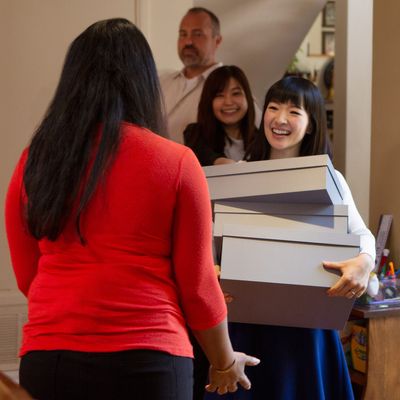
A lot of people in the Western world have way too much stuff. In 2014, many of them started looking to Marie Kondo to help them get rid of it.
That’s the year when the The Life-Changing Magic of Tidying Up, Kondo’s guide to cleansing one’s home, became an international best-seller and turned her into the most famous professional organizer on planet Earth. Thanks to her KonMari method, a decluttering process that involves sorting through one’s belongings based on categories and choosing to keep only the things that, in Kondo-ese, “spark joy,” Tidying Up became a phenomenon.
Starting on New Year’s Day, it also will be a TV show.
Tidying Up With Marie Kondo, a seemingly inevitable Netflix series inspired by the Kondo brand, follows the Japanese clutter purger into various homes as she guides mess makers through the process of curbing their excess crap and creating more manageable lives. The before-and-after sequences that close each episode give Tidying Up the vibe of a Trading Spaces–style home-improvement show, while the often-emotional process of transforming attitudes toward all those belongings — and doing so for individuals of various races, ethnicities, backgrounds, and sexual orientations — has more than a whiff of Queer Eye to it. Considering that this show is the literal equivalent of watching other people clean their houses, something I barely want to do myself, it is far more absorbing and interesting than I expected.
Perhaps that’s also because there’s a bit of Hoarders in Tidying Up, too. While some subjects merely fall in the disorganized category, there are some couples, like Wendy and Ron Akiyama, who have been married for decades and seemingly never gotten rid of a single thing, with a real, serious mound of mess to tackle. Wendy and Ron’s episode, “Empty Nesters,” reveals the boxes upon boxes of baseball cards that are stacked to the ceiling of their master bedroom, and the masses of Christmas decorations that have pretty much taken over the rec room. (Wendy has enough decorative nutcrackers to form her own military.) There is something oddly satisfying about seeing other people living in a more intense level of chaos than most of us do, yet still managing, by the end of a 35-minute episode, to confront it, overcome it, and effectively downsize.
Typically, when you read a self-help book like Kondo’s, the advice offered sounds deceptively simple. But turning a book like this into a TV show enables people to see how difficult it really is to execute. In the sixth episode, a married couple butts heads constantly because the wife, Suneeta, has a terrible time letting go of things and struggles with the whole concept of “sparking joy,” especially when it comes to her clothes. (Note: Suneeta has enough clothes to give Alex Honnold a new challenge to scale in the sequel to Free Solo.)
She tells Kondo she has a hard time deciding what to get rid of because, after gaining weight post-pregnancies, some of the clothes she truly loves are ones she can’t wear now but hopes to fit into again someday. (Suneeta: I see you and I totally get you.) In other words, the whole “sparking joy” idea — which made me roll my eyes all the way to the South Pole the first time I tried to grasp it — is much more complicated to act on than it is to read about. If you are not a hoarder necessarily, but perhaps hoarder-adjacent [hand slowly raises], it’s reassuring to see how tough it is for many people to shed things they don’t really need.
What’s nice about Tidying Up is that Kondo doesn’t judge her clients for their fixations and hang-ups. She tries to meet them in the middle. When Margie, a recent widow, tells Kondo she’d prefer to deal with her late husband’s clothes sooner in the process than Kondo typically recommends, Kondo gives her the space to do that. The conjurer of life-changing magic has been criticized for suggesting an approach to cleaning that seems too rigid, but she doesn’t come across as overly strict here. Either she’s more flexible than she has often gotten credit for, or she’s been propped up by the life-changing magic of solid reality-TV editing.
Actually, while the show can rightly be perceived as a commercial for Kondo’s books and other eventual products — earlier this year, she began offering a set of KonMari organizing boxes at a whopping $89 per set, all of which sold out — she doesn’t overly dominate the proceedings. Like a non-manic pixie clean girl, the diminutive guru, who speaks limited English, pops in and out of the various apartments and homes with her translator, and appears in short, subtitled segments that provide practical advice about how to do things like properly fold T-shirts or store important documents. But the eight episodes are as much about the men, women, and children trying to get their shit together as they are about Kondo.
Their stories, which are not just about getting rid of stuff but all the complicated, sentimental, and sometimes ridiculous reasons why we hold onto things, are the point of this series. You don’t want to recognize yourself in these “untidy” people who can’t bear to part with maternity clothes or high-school notes or the 85th nutcracker they collected. But you will. Well, maybe not when it comes to the nutcrackers. I can’t stress this enough: No one should ever want or need that many nutcrackers.


